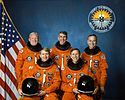STS-38
| STS-38 | |||||
 | |||||
| Uppdrag | 37 | ||||
|---|---|---|---|---|---|
| Rymdfärja | Atlantis (7)[1] | ||||
| NSSDC-ID | 1990-097A[2] | ||||
| Färdens tid | 4 dagar, 21 timmar, 54 minuter, 31 sekunder | ||||
| Uppskjutning | |||||
| Startplats | Startplatta 39A vid Kennedy Space Center i Florida | ||||
| Start | 15 november 1990, 6:48:13 p.m. EST | ||||
| Landning | |||||
| Landningsplats | KSC runway 33 | ||||
| Landning | 20 november 1990, 4:42:42 p.m. EST | ||||
| Omloppsbana | |||||
| Varv | 79 st[3] | ||||
| Apogeum | 78 km | ||||
| Perigeum | 226 km | ||||
| Banlutning | 28,5° | ||||
| Sträcka | 3,267 miljoner km | ||||
| Besättning | |||||
| Befälhavare | Richard O. Covey (3) | ||||
| Pilot | Frank L. Culbertson (1) | ||||
| Uppdragsspecialister | Robert C. Springer (2) Carl J. Meade (1) Charles D. Gemar (1) | ||||
 | |||||
| Kronologi Rymdfärjeprogrammet | |||||
| |||||
STS-38 var den trettiosjunde flygningen i det amerikanska rymdfärjeprogrammet och sjunde i ordningen för rymdfärjan Atlantis. Den sköts upp från Pad 39B vid Kennedy Space Center i Florida den 15 november 1990. Efter knappt fem dagar i omloppsbana runt jorden återinträdde rymdfärjan i jordens atmosfär och landade vid Kennedy Space Center.
Flygningen gjordes på uppdrag av USA:s försvarsdepartement.
Se även
Referenser
- ^ NASA Space Shuttle Launch Archive Arkiverad 27 maj 2010 hämtat från the Wayback Machine., läst 28 juli 2016.
- ^ ”NASA Space Science Data Coordinated Archive” (på engelska). NASA. https://nssdc.gsfc.nasa.gov/nmc/spacecraft/display.action?id=1990-097A. Läst 18 mars 2020.
- ^ Manned Astronautics - Figures & Facts Arkiverad 4 mars 2016 hämtat från the Wayback Machine., läst 28 juli 2016.
Externa länkar
 Wikimedia Commons har media som rör STS-38.
Wikimedia Commons har media som rör STS-38.
| ||||||||
| ||||||||||||||||||||||||||||||||
Media som används på denna webbplats
Författare/Upphovsman: Pascal (Flickr user: pasukaru76), Licens: CC0
Vostok spacecraft replica at the Technik Museum Speyer, Germany.
STS-41 Mission Insignia
The official STS-38 crew portrait includes the following 5 astronauts (front left to right): Frank L. Culbertson, pilot; and Richard O. Covey, commander. Standing (left to right) are mission specialists (MS) Charles D. (Sam) Gemar, (MS-3), Robert C. Springer, (MS-1), and Carl J. Meade, (MS-2). The seventh mission dedicated to the Department of Defense (DOD), the STS-38 crew launched aboard the Space Shuttle Atlantis on November 15, 1990 at 6:48:15 pm (EST).
STS-35 Mission Insignia
STS-38 Mission Insignia






